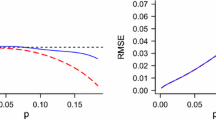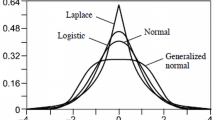Abstract
Various approximate methods have been proposed for obtaining a two-tailed confidence interval for the ratio R of two proportions (independent samples). This paper evaluates 73 different methods (64 of which are new methods or modifications of older methods) and concludes that: (1) none of the classic methods (including the well-known score method) is acceptable since they are too liberal; (2), the best of the classic methods is the one based on logarithmic transformation (after increasing the data by 0.5), but it is only valid for large samples and moderate values of R; (3) the best methods among the 73 methods is based on an approximation to the score method (after adding 0.5 to all the data), with the added advantage of obtaining the interval by a simple method (i.e. solving a second degree equation); and (4) an option that is simpler than the previous one, and which is almost as effective for moderate values of R, consists of applying the classic Wald method (after adding a quantity to the data which is usually \(z_{\alpha /2}^{2}/4\)).
Similar content being viewed by others
References
Agresti, A.: Dealing with discreteness: making ‘exact’ confidence intervals for proportions, differences of proportions, and odds ratios more exact. Stat. Methods Med. Res. 12, 3–21 (2003)
Agresti, A., Coull, B.A.: Approximate is better than “exact” for interval estimation of binomial proportions. Am. Stat. 52(2), 119–126 (1998)
Chen, L.-A., Hung, H.-N., Chen, C.-R.: Maximum average-power (MAP) tests. Commun. Stat., Theory Methods 36, 2237–2249 (2007)
Dann, R.S., Koch, G.G.: Review and evaluation of methods for computing confidence intervals for the ratio of two proportions and considerations for non-inferiority clinical trials. J. Biopharm. Stat. 15, 85–107 (2005)
Dunnett, C.W., Gent, M.: Significance testing to establish equivalence between treatments, with special reference to data in the form of 2×2 tables. Biometrics 33, 593–602 (1977)
Farrington, C.P., Manning, G.: Test statistics and sample size formulae for comparative binomial trials with null hypothesis of non-zero risk difference or non-unity relative risk. Stat. Med. 9, 1447–1454 (1990)
Gart, J.J., Nam, J.: Approximate interval estimation of the difference in binomial parameters: correction for skewness and extension to multiple tables. Biometrics 46, 637–643 (1990)
Herranz Tejedor, I., Martín Andrés, A.: A numerical comparison of several unconditional exact tests in problems of equivalence based on the difference of proportions. J. Stat. Comput. Simul. 78(11), 969–981 (2008)
Katz, D., Baptista, J., Azen, S.P., Pike, M.C.: Obtaining confidence intervals for the risk ratio in cohort studies. Biometrics 34, 469–474 (1978)
Koopman, P.A.R.: Confidence intervals for the ratio of two binomial proportions. Biometrics 40, 513–517 (1984)
Li, Y., Koval, J.J., Donner, A., Zou, G.Y.: Interval estimation for the area under the receiver operating characteristic curve when data are subject to error. Stat. Med. 29, 2521–2531 (2010)
Martín Andrés, A., Herranz Tejedor, I.: Asymptotic inferences about a linear combination of two proportions. JP J. Biostat. 4(3), 253–277 (2010)
Martín Andrés, A., Silva Mato, A.: Choosing the optimal unconditioned test for comparing two independent proportions. Comput. Stat. Data Anal. 17, 555–574 (1994)
Martín Andrés, A., Álvarez Hernández, M., Herranz Tejedor, I.: Inferences about a linear combination of proportions. Stat. Methods Med. Res. 20, 369–387 (2011). Erratum in 21(4), 427–428 (2012)
Maxwell, A.E.: Analysing Qualitative Data. Methuen, London (1961)
Miettinen, O., Nurminen, M.: Comparative analysis of two rates. Stat. Med. 4, 213–226 (1985)
Nam, J.-M.: Confidence limits for the ratio of two binomial proportions based on likelihood scores: non-iterative method. Biom. J. 37(3), 375–379 (1995)
Newcombe, R.G.: Interval estimation for the difference between independent proportions: comparison of eleven methods. Stat. Med. 17, 873–890 (1998)
Peskun, P.H.: A new confidence interval method based on the normal approximation for the difference of two binomial probabilities. J. Am. Stat. Assoc. 88(422), 656–661 (1993)
Price, R.M., Bonett, D.G.: An improved confidence interval for a linear function of binomial proportions. Comput. Stat. Data Anal. 45(3), 449–456 (2004)
Price, R.M., Bonett, D.G.: Confidence intervals for a ratio of two independent binomial proportions. Stat. Med. 27, 5497–5508 (2008)
Reiczigel, J., Abonyi-Tóth, Z., Singer, J.: An exact confidence set for two binomial proportions and exact unconditional confidence intervals for the difference and ratio of proportions. Comput. Stat. Data Anal. 52, 5046–5053 (2008)
StatXact7: CYTEL Software Corporation (2005). www.cytel.com
Upton, G.J.G.: A comparison of alternative tests for the 2×2 comparative trial. J. R. Stat. Soc. A 145(1), 86–105 (1982)
Walter, S.D.: The distribution of Levin’s measure of attribuible risk. Biometrika 62, 371–375 (1975)
Wilson, E.B.: Probable inference, the law of succession, and statistical inference. J. Am. Stat. Assoc. 22, 209–212 (1927)
Woolf, B.: On estimating the relation between blood group and disease. Ann. Hum. Genet. 19(4), 251–352 (1955)
Zou, G., Donner, A.: Construction of confidence limits about effect measures: a general approach. Stat. Med. 27, 1693–1702 (2008)
Acknowledgements
This research was supported by the Spanish Ministry of Education and Science; grant number MTM2009-08886 (and co-financed by the European Regional Development Fund).
Author information
Authors and Affiliations
Corresponding author
Appendix: Approximate value of the maximum likelihood estimator
Appendix: Approximate value of the maximum likelihood estimator
Martín Andrés et al. (2011) demonstrated that under the null hypothesis H:L=λ, with L=β 1 p 1+β 2 p 2, the maximum likelihood estimators p iE of the p i are in the solution for equations \(n_{i}( \bar{p}_{i} - p_{i\mathrm{E}} )/\beta_{i}p_{i\mathrm{E}}q_{i\mathrm{E}}=C (\forall i)\), when C is a constant that remains to be determined. This indicates that for i=1 one must have \(n_{1}\beta_{1}\bar{p}_{1} - n_{1}\beta_{1}p_{1\mathrm{E}} = C\{ \beta_{1}^{2}p_{1\mathrm{E}} - \beta_{1}^{2}p_{1\mathrm{E}}^{2} \}\), whilst for i=2 it will be \(n_{2}\beta_{2}\bar{p}_{2} - n_{2}\beta_{2}p_{2\mathrm{E}} = C\{ \beta_{2}^{2}p_{2\mathrm{E}} - \beta_{2}^{2}p_{2\mathrm{E}}^{2} \}\). As β 2 p 2E=λ−β 1 p 1E, by substituting in the second equality above it can be deduced that \(n_{2}\beta_{2}\bar{p}_{2} - n_{2}\lambda + n_{2}\beta_{1}p_{1\mathrm{E}} = C\{ \lambda( \beta_{2} - \lambda) - \beta_{1}^{2}p_{1\mathrm{E}}^{2} + \beta_{1}p_{1\mathrm{E}}( 2\lambda - \beta_{2} ) \}\), so that by subtracting this equality from the one in the case i=1 and working out p iE one gets \(p_{1\mathrm{E}} = \{ ( n_{2}\beta_{2}\bar{p}_{2} - n_{1}\beta_{1}\bar{p}_{1} - n_{2}\lambda) - \lambda( \beta_{2} - \lambda)C \}/ \{ - n\beta_{1} + \beta_{1}C( 2\lambda - \beta_{1} - \beta_{2} ) \}\). By doing the division, and disregarding all terms lower than or equal to −1, one can deduce that \(p_{1\mathrm{E}} \approx p_{1\mathrm{A}} = ( n_{1}\beta_{1}\bar{p}_{1} - n_{2}\beta_{2}\bar{p}_{2} + n_{2}\lambda) / ( n\beta_{1} )\), and given that \(p_{2\mathrm{E}} = ( \lambda - \beta_{1}p_{1\mathrm{E}} )/\beta_{2},p_{2\mathrm{E}} \approx p_{2\mathrm{A}} = ( - n_{1}\beta_{1}\bar{p}_{1} + n_{2}\beta_{2}\bar{p}_{2} + n_{1}\lambda) / ( n\beta_{2} )\) where p 2A=(λ−β 1 p 1A)/β 2.
When the interest is on the hypothesis H:d=δ for the difference of proportions d=p 2−p 1, then β 1=−1,β 2=+1,λ=δ and the previous expression indicates that p 1A=(a 1−n 1 δ)/n and p 2A=(a 1+n 2 δ)/n: the classic conditioned estimators of Dunnett and Gent (1977).
When the interest lies in the hypothesis H:R=ρ for the ratio of proportions R=p 2/p 1 then, as the previous hypothesis is equivalent to H:L=p 2−ρp 1=0, one will have β 1=−ρ,β 2=+1 and λ=0. Substituting these values in the two previous expressions for the p iA we obtain the estimators for expression (12), which have been corrected in order to avoid p iA being greater than 1.
Rights and permissions
About this article
Cite this article
Martín Andrés, A., Álvarez Hernández, M. Two-tailed approximate confidence intervals for the ratio of proportions. Stat Comput 24, 65–75 (2014). https://doi.org/10.1007/s11222-012-9353-5
Received:
Accepted:
Published:
Issue Date:
DOI: https://doi.org/10.1007/s11222-012-9353-5




